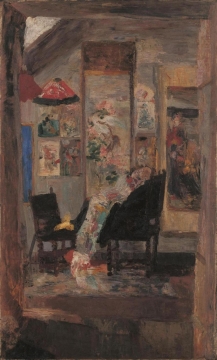Co-organized with the Art Institute of Chicago, the exhibition focuses on Ensor’s work during the 1880s and 1890s. Over a ten-year period, Ensor gradually abandoned academic naturalism and turned to a satiric presentation of society. His style became increasingly marked by vibrant, contrasting, acid colours and his choice of motifs, such as masques and skeletons, moved to the morbid.
Squelette regardant chinoiseries is a good illustration of the artist’s development. We see a character sitting in an armchair, calmly reading, but on closer inspection, the person turns out to be a skeleton dressed in bourgeois clothes. The painting is one that Ensor re-worked towards the end of the 1880s and infrared and X-ray analyses of the work have revealed the head of an old man beneath the skull.
The exhibition has brought together around a hundred of Ensor’s works and testifies to the dexterity of this versatile artist, who was equally at home working with a brush, a crayon or a burin. Squelette regardant chinoiseries, one of the masterpieces of the Foundation collection, is in dialogue with some of Ensor’s self-portraits. The work also evokes, satirically, the well-to-do interiors of the period. Some sixty works in the exhibition have been lent by the Royal Museum of Fine Arts in Antwerp, which is taking advantage of its temporary closure for renovation to get its collection better known abroad.
“To this day, Ensor’s art continues to baffle in its psychological complexity, internal contradictions, and sheer eccentricity. In a few short years, a breath-taking trajectory took the artist from academic naturalist to something so biting, defiant and bizarre that it still defies categorization and eludes rational analysis.” Exhibition curator Scott Allan.
Practical information:
J. Paul Getty Museum, 1200 Getty Center Drive, Los Angeles
From 10 June to 7 September 2014
Tuesday to Friday and Sunday from 10h to 17h30
Saturday from 10h to 21h
Closed on Monday
The Art Institute of Chicago, 111 S. Michigan Avenue, Chicago
23 November 2014 to 25 January 2015
Open every day from 10h30 to 17h
Thursday until 20h
